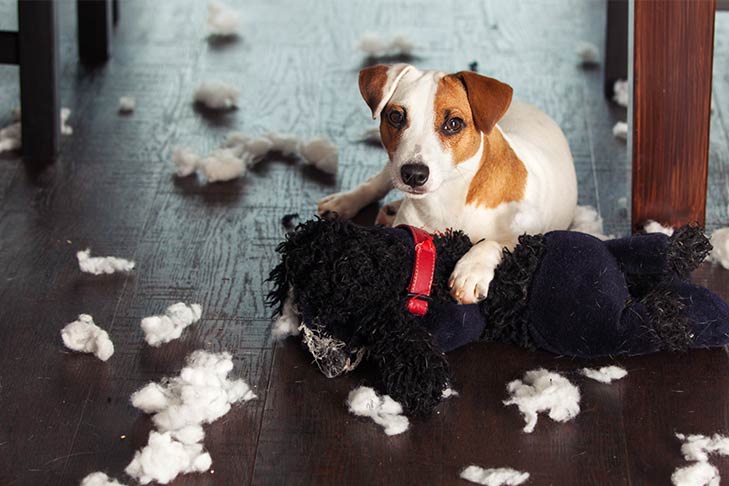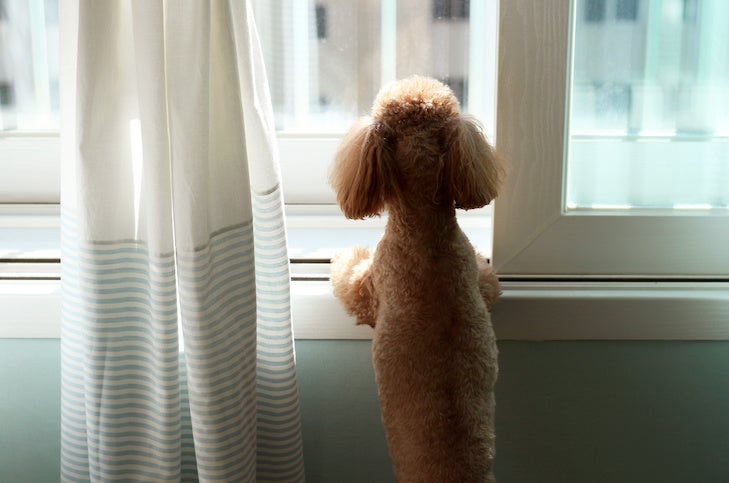AKC is a participant in affiliate advertising programs designed to provide a means for sites to earn advertising fees by advertising and linking to akc.org. If you purchase a product through this article, we may receive a portion of the sale.
When you’re raising a puppy, there can be a parade of behavioral issues that march through their—and your—life. Separation anxiety can be one of them. Understanding and recognizing separation anxiety in dogs will prepare you to do all you can to prevent the condition as well as to address it at the first signs.
Although older dogs can develop separation anxiety, it often affects young dogs. So learn to prevent dog separation anxiety before it starts.
What Is Dog Separation Anxiety?
Whether in a puppy or an adult dog, separation anxiety is when your dog exhibits extreme stress from the time you leave them alone until you return. The symptoms can vary, but they will act as if they are terrified to be in the house on their own. According to Patricia McConnell, Ph.D. a Certified Applied Animal Behaviorist, although we can’t know for sure what’s in a dog’s mind, we can think of separation anxiety as the equivalent of a panic attack.
Here’s the good news: As the responsible owner of a new puppy, hopefully you’re already laying the foundation for a well-adjusted, well-behaved dog. Puppy training, socialization, crate training, and teaching your puppy how to enjoy being alone all contribute. Therefore, many of the recommendations here are things you may already be doing or have already done. That said, separation anxiety does present some unique challenges.
The Difference Between Separation Anxiety and Normal Canine Behavior
Separation anxiety is a serious condition, and it goes beyond the occasional mournful whimper when you leave the house or the shredded sock waiting for you upon your return. It’s also not the same as boredom, and unlike a little mischief when your dog is left alone, separation anxiety is the result of legitimate stress.
Before labeling destroyed cushions or potty accidents as separation anxiety, be sure it’s not a case of inadequate training. Does your dog truly understand good manners, even when you’re not watching them? Are they 100% potty trained? One of the best ways to see what’s really going on in your absence is to get audio or video footage of your dog’s behavior while you’re away.
What Are the Signs of Separation Anxiety in Dogs?
Dogs can exhibit stress in many ways, so there is no one defining sign of separation anxiety. Instead, there are a variety of symptoms. One or two of them, especially if they only happen occasionally, may not be a sign of puppy separation anxiety. But if your puppy shows multiple symptoms on a regular basis, they may be suffering from separation anxiety. Here are some behaviors your dog may exhibit:
- Anxious behaviors like pacing, whining, or trembling while you’re gone or as you prepare to leave.
- Excessive barking or howling.
- Destructive acts, such as chewing or digging, particularly around doors or windows.
- Accidents in the house – urinating or defecating.
- Excessive salivation, drooling, or panting.
- Desperate and prolonged attempts to escape confinement, potentially ending in serious injury.
According to research published in the Journal of Applied Animal Welfare Science, several of the above symptoms are also some of the most common reasons owners get rid of their dogs. This is especially unfortunate because it’s an issue that can be treated by implementing a few simple but important tactics.

What Causes Separation Anxiety in Puppies and Dogs?
It’s unclear why some puppies are more prone to separation anxiety than others. McConnell theorizes there may be several reasons, including never previously being left alone and traumatic separation (such as would be seen in some abandoned shelter dogs). Even a single traumatic event in the owner’s absence, like the house being robbed, can lead to separation anxiety. Finally, she suggests that personality can play a role, with clingy dogs perhaps being more at risk than independent ones.
Other triggers to watch for involve life changes like a sudden switch in schedule, a move to a new house, or the sudden absence of a family member, whether it’s a divorce, a death in the family, or a child leaving for college. Some research has even pointed to a lack of daily exercise as a possible cause. Because there are so many potential triggers for separation anxiety, it’s essential to work on prevention and start treatment at the first sign.
What Can I Do About My Dog’s Separation Anxiety?
It’s exhausting to come home to destruction and upsetting to see your puppy in such distress. It’s even more devastating for your dog. Thankfully, there are several steps you can take to deal with separation anxiety. Some of the treatments are the same as the preventative measures and may already be part of your puppy’s routine. But consider all of them as you tackle separation anxiety. Look at the following methods of treatment:
Crate Training
It bears repeating that a crate is your dog’s friend and your ally. It’s an important training tool and the solution for many puppy challenges. It isn’t cruel or unhealthy if used appropriately. Instead, it can provide your pup with a safe, quiet place to relax. The trick is to teach them to associate their crate with wonderful things like chew toys and food-releasing puzzle toys so they are happy to spend time inside. Some dogs feel safer and more comfortable in their crate when left alone. However, other dogs can panic. Watch your puppy’s behavior to see if they settle right down or if the anxiety symptoms ramp up. Remember, the goal is not to crate your dog all day, every day as a solution to their separation anxiety. It’s to keep them and your house safe while you teach them to enjoy being alone.
Desensitization and Counter-Conditioning
An important part of raising a mentally and physically healthy new puppy is teaching them to be comfortable in the world and to form positive associations with new experiences. That’s equally true for time away from you. Teach your puppy that separation has its rewards. Start by leaving them for very short periods of time and gradually lengthen the amount of time you’re gone. If your puppy is already conditioned to go into stress mode when they know you’re leaving them, try countering that reaction by using a high-value treat they really love and that you only bring out for important lessons and rewards. If they get a special treat right before you leave, they might even begin to look forward to your departure.
You can also make your departure routine less distressing by desensitizing your puppy to the signs you’re about to go out. For example, pick up your keys or put on your coat, then go make dinner rather than heading to the car. Even better, toss your puppy a high-value treat right before you touch your keys or coat. In time, they will look forward to the signs you’re about to leave rather than panicking.

Exercise
Exercise can’t cure separation anxiety, but it certainly can help treat and prevent it. First, make sure your puppy gets plenty of age-appropriate physical exercise. This is especially true for large, high-energy dogs with a lot of it to burn off. A tired, contented dog who’s had a brisk walk and playtime with you is more likely to settle down when you leave. Second, don’t neglect your puppy’s mental muscles. Training sessions, puzzle toys, and cognitive games are all good choices. A brain workout can be just as exhausting as a physical one: and lots of fun, too.
Clinginess: Playing it Cool
Don’t encourage overly clingy behavior. Instead, develop independence by teaching your puppy to be on their own in another room, even when you’re at home. Teaching a solid stay is another way to battle excessive attachment. Start with short lengths of time, and once your puppy can stay for several minutes, you can begin to leave the room. Eventually, you should be able to leave his sight while they stay for five or ten minutes.
It’s also important to play it cool when you leave or return to your home. You can greet your dog with love, but don’t get over-the-top emotional. Keep things calm and without fanfare. If you get worked up, your dog will see your comings and goings as a major event to worry over. Plus, if you return home to damage or accidents, don’t punish your dog. You will only add to their anxiety and worsen the problem.
Medication and Natural Supplements
Sometimes, training and counter-conditioning are not enough. Some vets recommend medication such as amitriptyline, which is used to treat depression, or alprazolam, which is prescribed for anxiety and panic disorders. These require a prescription and are safe for most pets, though you’ll need to consult with your vet; be extra diligent about the use of medication with a young dog.
Another option is supplements and homeopathic treatment. Natural products like CBD or valerian might bring your dog relief from separation anxiety, or at least smooth the way during your training program. Just be sure to consult with your vet before giving your dog any over-the-counter products, particularly if they are already on prescription medications. Other options for canine anxiety relief include dog-appeasing pheromone collars or diffusers and compression shirts.
Can Separation Anxiety Always Be Prevented?
Separation anxiety in puppies and dogs isn’t always preventable, despite your best efforts. And once separation anxiety has taken hold, it can be a complicated process to treat. Consider working with a Certified Applied Animal Behaviorist or a veterinary behaviorist to help smooth the process.
However, as serious as this condition may be, McConnell assures it has a high rate of treatment success. With patience and a positive attitude, you may be able to reduce your dog’s suffering and put separation anxiety stress behind you.
Whether your dog gets stressed during fireworks, managing ongoing hip & joint issues, or if you want to incorporate a general wellness supplement into their everyday routine, Pet Releaf has your pet’s perfect CBD match. As the original and #1 CBD brand, Pet Releaf has helped more than 5 million pets live happier, healthier lives. Pet Releaf’s USDA-certified organic CBD chews and CBD oils are safe and effective, using third-party testing to ensure quality products. Designed by veterinarians, Pet Releaf products can help dogs of all sizes, ages, and health statuses. AKC readers get exclusive access to 10% off all Pet Releaf products using 10AKC.


